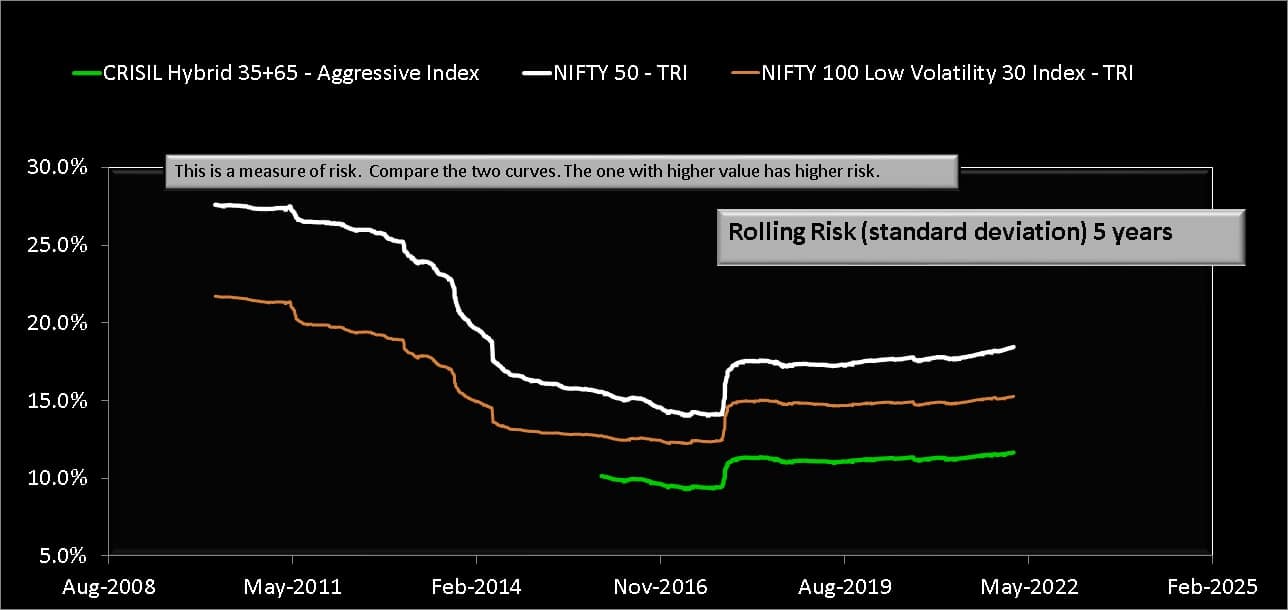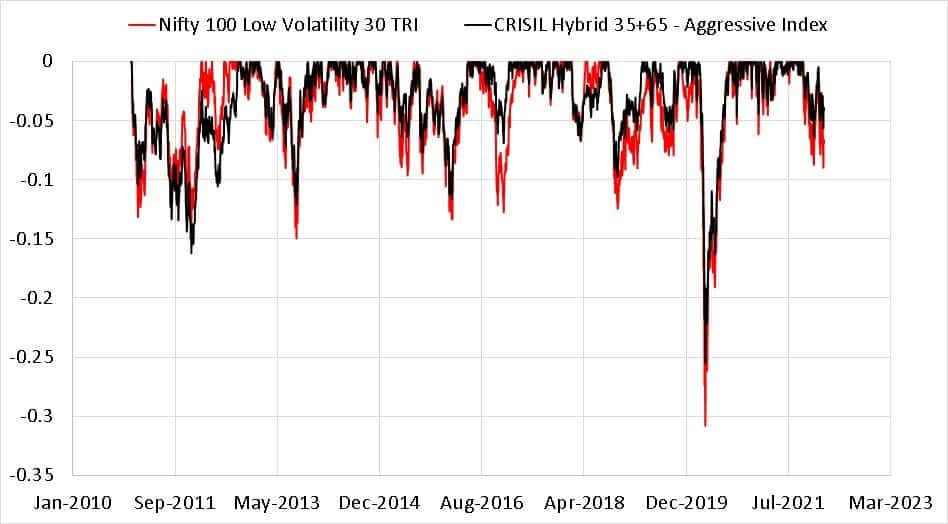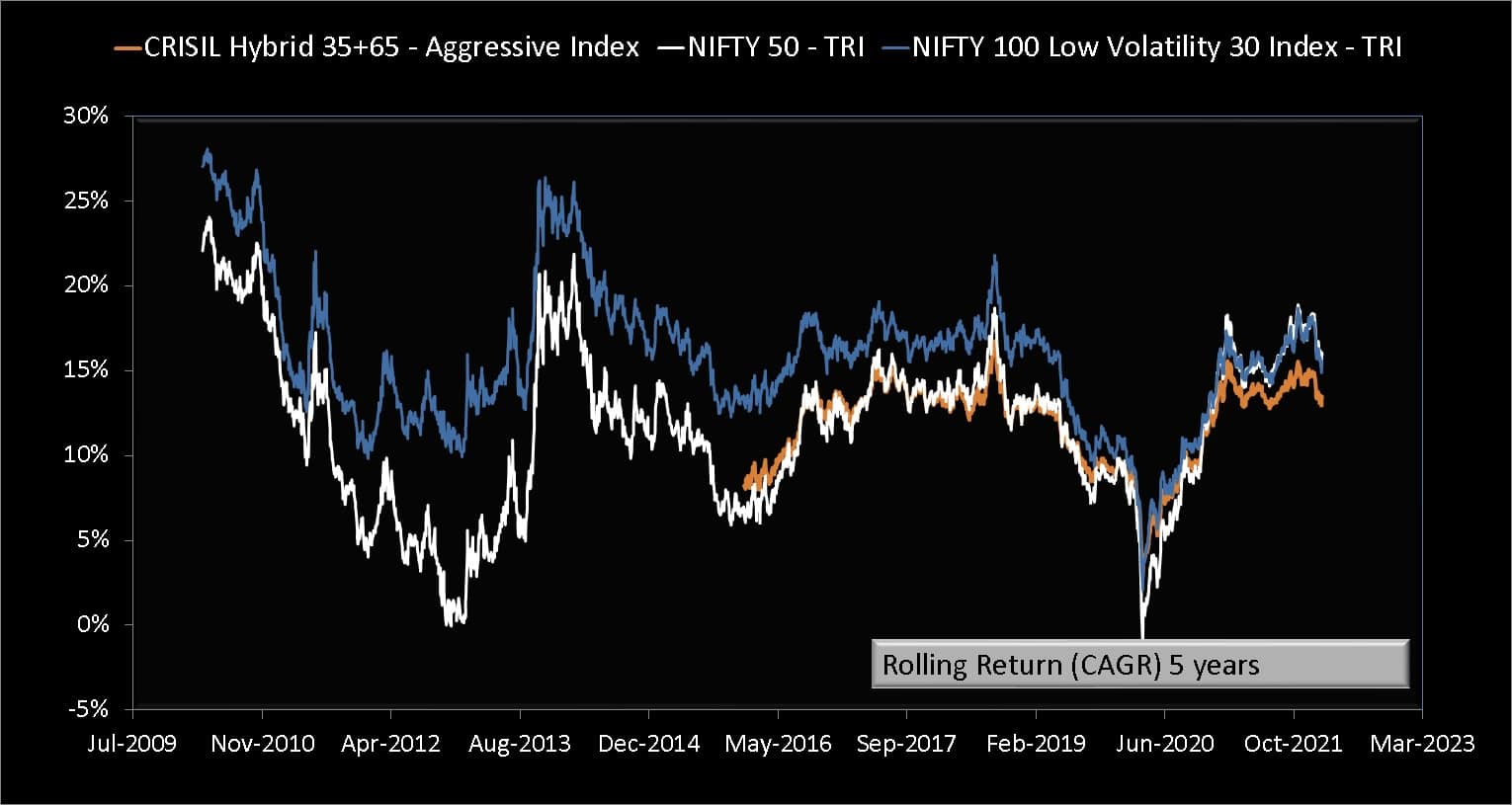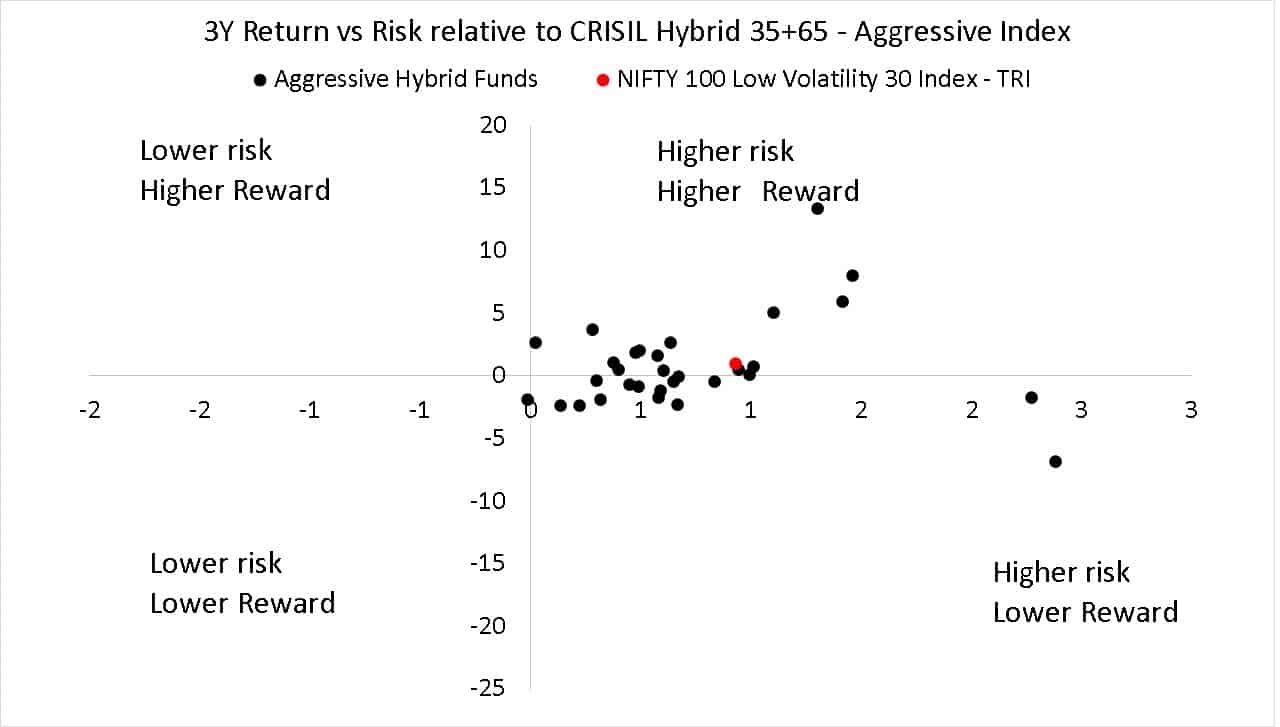Last Updated on September 5, 2022 at 4:49 pm
After the publication of our review of UTI S&P BSE Low Volatility Index Fund, we have received several requests from readers to compare low volatility indices with aggressive hybrid funds/indices.
Such a comparison may seem wrong at first glance. After all, how can we compare a 100% equity portfolio with a 65%-80% equity portfolio? However, a comparison of risk and reward helps us relatively grade and form the correct expectation from aggressive hybrid and low volatility indices.
The aggressive hybrid index considered here has 65% of BSE 200 and 25% of Crisil Composite Bond index. Unlike an actively managed aggressive hybrid fund, the equity allocation is fixed and the lowest possible to qualify as an equity fund for taxation. It must be kept in mind that at the time of writing, there are no aggressive hybrid index funds.
Let us start with the 5Y Rolling standard deviation of Nifty 100 Low Volatility 30 Index vs CRISIL Hybrid 35+65 – Aggressive Index vs Nifty 50 TRI. The standard deviation is a measure of much the monthly returns deviates from the average monthly return. This is a measure of volatility. Higher the value, the higher the volatility and the higher the likelihood of a deviation from an expected return.
Join 32,000+ readers and get free money management solutions delivered to your inbox! Subscribe to get posts via email! (Link takes you to our email sign-up form)
🔥Want to create a complete financial plan? Learn goal-based investing? Exclusive access to our DIY tools? Increase your income with your skills? Enjoy massive discounts on our robo-advisory tool & courses! 🔥

The hybrid index has the lowest volatility as it has only 65% of equity. The low volatility index falls in between the hybrid index and Nifty 50. For the same reason, the drawdown or the fall from a previous maximum is also lower for the hybrid index.

Next, the rolling returns over five years.

Notice that the hybrid index has a return typically comparable to the NIfty. This is the reason why asset allocation is referred to as a “free lunch”. That is just by substituting 35% of stocks with bonds, we have reduced the risk but not the return (typically). This means asset allocation (or in this case, an aggressive hybrid index) enables us to get a better risk-adjusted return (return obtained per unit risk taken).
The low volatility index has (so far) typically outperformed the Nifty over 5 years (and more) and it does so at a lower risk.
Now the question is, which index offers more reward for the risk taken. We shall compute the alpha wrt Nifty 50 and a risk-free rate of 4% a year.
Alpha = (Fund return – risk-free return) – (Benchmark return – risk-free return) x beta
Beta is the relative volatility wrt Nifty.
Since 31 Dec 2010 (the earliest date for which hybrid index data is available ), the low volatility index has a beta of 0.76. That is its volatility is only 76% of that of the NIfty. The hybrid index has a volatility of 0.63.
Alpha for the low volatility index is 1.69% while that for the hybrid index is 0.99%. Other risk-adjusted return measures are given below. For a simple understanding of these, refer to Visualizing Mutual Fund Volatility Measures and What is a risk-adjusted return?
| Metric | CRISIL Hybrid 35+65 – Aggressive Index | Nifty 100 Low Volatility 30 TRI |
| BETA | 0.63 | 0.76 |
| Sharpe | 4.80% | 5.07% |
| Alpha | 0.99% | 1.69% |
| Sortino | 7.50% | 8.04% |
| Treynor | 5.35% | 6.00% |
So the low volatility (so far) has been able to provide a bit higher reward for the risk taken.
Actively managed aggressive hybrid funds vs Nifty 100 Low Volatility 30 Index
We shall now compare the risk and reward of actively managed aggressive hybrid funds with the hybrid index and low vol index. To do this we shall plot the reduced return vs the reduced standard deviation (x-axis).
Reduced return = fund return minus hybrid index return
Reduced standard deviation = fund std dev minus hybrid index std dev.
The data below is for 3Y and 5Y. In this graph, the origin (x=0, y =0) represents the hybrid index. All other data is relative to this.


Over the last 3Y and 5Y, the low volatility index has outperformed the hybrid index. Although these graphs give the impression that many agg. hybrid funds have also done the same, caution is necessary.
According to the Equity Mutual Fund Screener Feb 2022, only 6 out 30 agg. hybrid funds have consistently outperformed the hybrid index at least 70% of all possible 3Y and 5Y duration from Jan 2013 to Feb 2022. So finding a “future” agg. hybrid fund performer is not practical.
Let us summarise:
If an aggressive hybrid index fund is launched is it a good replacement for a Nifty index fund? Certainly with usual caveats of expense ratio, tracking error and AUM. If such a fund is launched, I shall certainly consider investing in it.
Assuming we can choose between a hybrid index fund and a low volatility index fund, which is better? As mentioned earlier, a low vol index is a passively managed route to try and beat the market. A hybrid index does not have such a mandate.
So investors who wish to try and get better absolute returns (with better risk-adjusted returns as a min guarantee) can consider a low vol index. Investors who desired only guaranteed better risk-adjusted returns can opt for a hybrid index (when it becomes available) or settle with active agg. hybrid funds.
Is an actively managed aggressive hybrid fund better than UTI low volatility index fund? It is quite easy to choose such agg. hybrid funds based on past performance. However, it is unlikely to sustain in future. Also with the exception of one or two agg. hybrid funds (in search of AUM) many are likely to be at least twice as expensive as the UTI low volatility index fund.
While there is nothing wrong with investing in active agg. hybrid funds, there is no evidence to claim that they are better than a low vol index fund.
🔥Enjoy massive discounts on our courses, robo-advisory tool and exclusive investor circle! 🔥& join our community of 7000+ users!
Use our Robo-advisory Tool for a start-to-finish financial plan! ⇐ More than 2,500 investors and advisors use this!
Track your mutual funds and stock investments with this Google Sheet!
We also publish monthly equity mutual funds, debt and hybrid mutual funds, index funds and ETF screeners and momentum, low-volatility stock screeners.





- Do you have a comment about the above article? Reach out to us on Twitter: @freefincal or @pattufreefincal
- Have a question? Subscribe to our newsletter using the form below.
- Hit 'reply' to any email from us! We do not offer personalized investment advice. We can write a detailed article without mentioning your name if you have a generic question.
Join 32,000+ readers and get free money management solutions delivered to your inbox! Subscribe to get posts via email! (Link takes you to our email sign-up form)
About The Author
 Dr M. Pattabiraman(PhD) is the founder, managing editor and primary author of freefincal. He is an associate professor at the Indian Institute of Technology, Madras. He has over ten years of experience publishing news analysis, research and financial product development. Connect with him via Twitter(X), Linkedin, or YouTube. Pattabiraman has co-authored three print books: (1) You can be rich too with goal-based investing (CNBC TV18) for DIY investors. (2) Gamechanger for young earners. (3) Chinchu Gets a Superpower! for kids. He has also written seven other free e-books on various money management topics. He is a patron and co-founder of “Fee-only India,” an organisation promoting unbiased, commission-free investment advice.
Dr M. Pattabiraman(PhD) is the founder, managing editor and primary author of freefincal. He is an associate professor at the Indian Institute of Technology, Madras. He has over ten years of experience publishing news analysis, research and financial product development. Connect with him via Twitter(X), Linkedin, or YouTube. Pattabiraman has co-authored three print books: (1) You can be rich too with goal-based investing (CNBC TV18) for DIY investors. (2) Gamechanger for young earners. (3) Chinchu Gets a Superpower! for kids. He has also written seven other free e-books on various money management topics. He is a patron and co-founder of “Fee-only India,” an organisation promoting unbiased, commission-free investment advice.Our flagship course! Learn to manage your portfolio like a pro to achieve your goals regardless of market conditions! ⇐ More than 3,000 investors and advisors are part of our exclusive community! Get clarity on how to plan for your goals and achieve the necessary corpus no matter the market condition is!! Watch the first lecture for free! One-time payment! No recurring fees! Life-long access to videos! Reduce fear, uncertainty and doubt while investing! Learn how to plan for your goals before and after retirement with confidence.
Our new course! Increase your income by getting people to pay for your skills! ⇐ More than 700 salaried employees, entrepreneurs and financial advisors are part of our exclusive community! Learn how to get people to pay for your skills! Whether you are a professional or small business owner who wants more clients via online visibility or a salaried person wanting a side income or passive income, we will show you how to achieve this by showcasing your skills and building a community that trusts and pays you! (watch 1st lecture for free). One-time payment! No recurring fees! Life-long access to videos!
Our new book for kids: “Chinchu Gets a Superpower!” is now available!


Must-read book even for adults! This is something that every parent should teach their kids right from their young age. The importance of money management and decision making based on their wants and needs. Very nicely written in simple terms. - Arun.Buy the book: Chinchu gets a superpower for your child!
How to profit from content writing: Our new ebook is for those interested in getting side income via content writing. It is available at a 50% discount for Rs. 500 only!
Do you want to check if the market is overvalued or undervalued? Use our market valuation tool (it will work with any index!), or get the Tactical Buy/Sell timing tool!
We publish monthly mutual fund screeners and momentum, low-volatility stock screeners.
About freefincal & its content policy. Freefincal is a News Media Organization dedicated to providing original analysis, reports, reviews and insights on mutual funds, stocks, investing, retirement and personal finance developments. We do so without conflict of interest and bias. Follow us on Google News. Freefincal serves more than three million readers a year (5 million page views) with articles based only on factual information and detailed analysis by its authors. All statements made will be verified with credible and knowledgeable sources before publication. Freefincal does not publish paid articles, promotions, PR, satire or opinions without data. All opinions will be inferences backed by verifiable, reproducible evidence/data. Contact information: To get in touch, use this contact form. (Sponsored posts or paid collaborations will not be entertained.)
Connect with us on social media
- Twitter @freefincal
- Subscribe to our YouTube Videos
- Posts feed via Feedburner.
Our publications
You Can Be Rich Too with Goal-Based Investing
 Published by CNBC TV18, this book is meant to help you ask the right questions and seek the correct answers, and since it comes with nine online calculators, you can also create custom solutions for your lifestyle! Get it now.
Published by CNBC TV18, this book is meant to help you ask the right questions and seek the correct answers, and since it comes with nine online calculators, you can also create custom solutions for your lifestyle! Get it now.Gamechanger: Forget Startups, Join Corporate & Still Live the Rich Life You Want
 This book is meant for young earners to get their basics right from day one! It will also help you travel to exotic places at a low cost! Get it or gift it to a young earner.
This book is meant for young earners to get their basics right from day one! It will also help you travel to exotic places at a low cost! Get it or gift it to a young earner.Your Ultimate Guide to Travel
 This is an in-depth dive into vacation planning, finding cheap flights, budget accommodation, what to do when travelling, and how travelling slowly is better financially and psychologically, with links to the web pages and hand-holding at every step. Get the pdf for Rs 300 (instant download)
This is an in-depth dive into vacation planning, finding cheap flights, budget accommodation, what to do when travelling, and how travelling slowly is better financially and psychologically, with links to the web pages and hand-holding at every step. Get the pdf for Rs 300 (instant download)